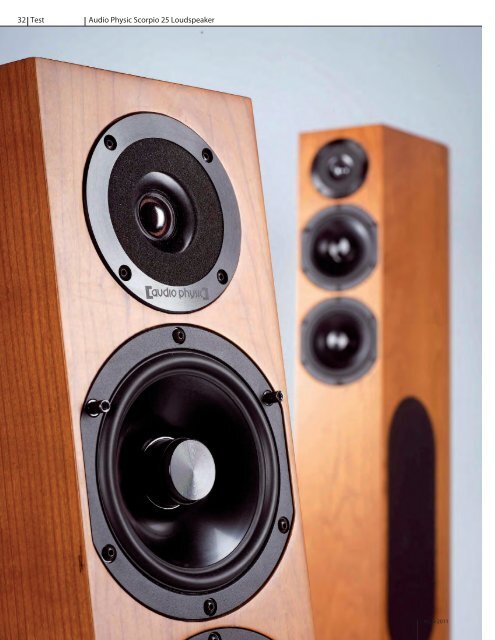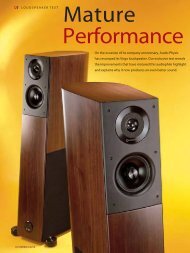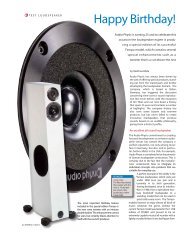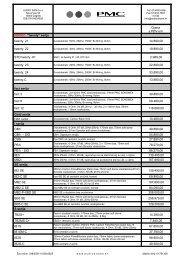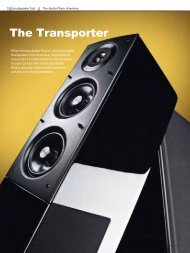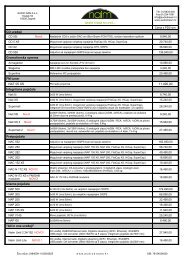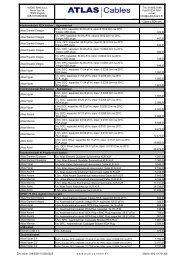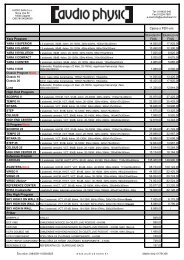32 Test Audio Physic Scorpio 25 Loudspeaker
32 Test Audio Physic Scorpio 25 Loudspeaker - Audio dream
32 Test Audio Physic Scorpio 25 Loudspeaker - Audio dream
Create successful ePaper yourself
Turn your PDF publications into a flip-book with our unique Google optimized e-Paper software.
<strong>32</strong> <strong>Test</strong> <strong>Audio</strong> <strong>Physic</strong> <strong>Scorpio</strong> <strong>25</strong> <strong>Loudspeaker</strong><br />
Nr_3-2011
<strong>Loudspeaker</strong><br />
<strong>Test</strong><br />
33<br />
Technology<br />
with Passion<br />
I am welcomed to the website by a huge “<strong>25</strong>”, happily filling the entire screen.<br />
Indeed, <strong>25</strong> years of <strong>Audio</strong> <strong>Physic</strong> is certainly a cause for celebration and the company<br />
from Brilon, Germany, is doing so by producing improved special editions<br />
of its most successful models. The latest model to undergo this special treatment<br />
is the <strong>Scorpio</strong>, which celebrated its world premiere in our listening room.<br />
T<br />
hey have all had their turn. The Tempo,<br />
the Virgo, the Avanti and, of course, the<br />
company’s flagship: the Cardeas. Only the<br />
<strong>Scorpio</strong> was still waiting for its moment; the<br />
loudspeaker that I considered to be<br />
equipped with a small dome tweeter with<br />
sound conduction at first glance. I was,<br />
however, rapidly corrected by Manfred<br />
Diestertich, who declared that the <strong>Scorpio</strong><br />
has a cone tweeter. A what? A cone in the<br />
tweeter, in the entire medium and top class<br />
and right through to the reference class? If<br />
you browse through our magazine “KLANG<br />
+ TON” now and again, you will know that we<br />
are indeed inclined towards the few tweeter<br />
cones that have survived into the present<br />
day. Nevertheless, I never would have<br />
thought that I would see such technology,<br />
which is assumed to be extinct, in a freshly<br />
revamped anniversary model of a<br />
floor-standing loudspeaker for 5000 Euros.<br />
Of course, <strong>Audio</strong> <strong>Physic</strong> does not<br />
rely on a run-of-the-mill product but has<br />
instead commissioned its driver supplier to<br />
follow strict specifications and produce a<br />
cone developed by <strong>Audio</strong> <strong>Physic</strong> itself. The<br />
Hyper Holographic Cone Tweeter II, or<br />
HHCT II for short, therefore has little in<br />
common with the well-known cheap cones<br />
and their characteristic sound. In fact, the<br />
HHCT II works its magic exactly where<br />
common domes falter, namely where<br />
controlled diaphragm movements are<br />
concerned. The manufacturers do indeed<br />
have an excellent grasp of this technology<br />
thanks to their many years of experience, but<br />
this does not change anything about the<br />
general principle: a soft fabric diaphragm<br />
that no longer follows its voice coil in a piston<br />
shape at frequencies above x but instead<br />
opens out in partial vibrations. The fact that it<br />
therefore adds its own sound to the actual<br />
musical signal is an obvious consequence.<br />
In order to avoid this problem,<br />
<strong>Audio</strong> <strong>Physic</strong> relies on a cone with a<br />
diameter of close to 40mm (1.5”) and with a<br />
practical fabric dustcap that does not<br />
contribute to the radiation of sound. The<br />
exterior contains a wide foam ring that<br />
ensures defined damping. The cone is open<br />
at the back, which is why the tweeter has<br />
been given its own small chamber in the<br />
<strong>Scorpio</strong> in order to protect it against pressure<br />
waves from the woofer. When describing<br />
the HHCT II, Manfred Diestertich certainly<br />
doesn’t hold back on his words, stating that:<br />
“Once you’ve gotten used to it, your friendship<br />
with domes will suffer considerably.” I’m<br />
excited to try it out for myself…<br />
Where the other technology used<br />
in the <strong>Scorpio</strong> <strong>25</strong> is concerned, it soon becomes<br />
clear that Diestertich is by no means<br />
excessively boasting about his product. The<br />
abundance of ideas certainly does not end<br />
at the tweeter but runs throughout the<br />
loudspeaker, for example in its two 15cm<br />
(6’’) midrange drivers. These drivers, which<br />
are fittingly called the HHCMs, involve at<br />
least just as much brain power as the<br />
tweeter cone. The double loudspeaker<br />
basket made of die-cast aluminium and<br />
plastic is a prime example, with the external<br />
aluminium guaranteeing rigidity and cooling<br />
the powerful neodymium magnet while a<br />
second plastic basket on the inside decouples<br />
the moving system from the loudspeaker<br />
cabinet. In order to keep the aluminium<br />
diaphragm, which produces a very precise<br />
sound but is also known to be afflicted with<br />
resonance, under control, <strong>Audio</strong> <strong>Physic</strong><br />
uses an elastic ring fitted around the edge of<br />
the diaphragm. The silicon ring mechanically<br />
tightens the cone and extremely effectively<br />
damps the ringing of the metal.<br />
The four 17cm (7’’) woofers also<br />
rely on this hard material for their sound<br />
production. These drivers are placed opposite<br />
each other in pairs at the base of the<br />
cabinet and cancel out each others vibrations<br />
transmitted to the cabinet. Thanks to its<br />
perfectly designed parameters, the quartet<br />
of woofers in the ventilated cabinet takes up<br />
so little room that the <strong>Scorpio</strong> <strong>25</strong> does not<br />
get out of hand in terms of size. Indeed, the<br />
opposite applies and the loudspeaker has<br />
an extremely elegant and harmonious<br />
appearance due to its slim silhouette, lightly<br />
curved sides and slanted shape.<br />
Protagonists<br />
Turntable:<br />
· Acoustic Solid Machine with SME<br />
M2-12 and Clearaudio Goldfi nger<br />
Phono-preamplifier:<br />
· Malvalve preamp three phono<br />
Preamplifier:<br />
· Malvalve preamp three line<br />
Amplifier:<br />
· KLANG+TON SymAsym<br />
Accessories:<br />
· Power bar: PS-<strong>Audio</strong><br />
· Power cord: Silent Wire<br />
· Low frequency cable: Silent Wire<br />
· Phonokabel: Van den Hul<br />
· Phono cable: Intertechnik<br />
· Racks: Copulare<br />
· Record cleaning machine : Clearaudio<br />
Antagonists<br />
Side-mounted woofers allow the <strong>Scorpio</strong> <strong>25</strong> to have a slim<br />
silhouette, while a low crossover frequency to the powerful<br />
midrange drivers ensures clear spatial imaging<br />
· Isophon Cassiano<br />
· B&W 800 Diamond<br />
· Ascendo C8<br />
Nr_3-2011
34 <strong>Test</strong> <strong>Audio</strong> <strong>Physic</strong> <strong>Scorpio</strong> <strong>25</strong> <strong>Loudspeaker</strong><br />
Air – Moon Safari<br />
Music Played<br />
Air<br />
Moon Safari<br />
Björk<br />
Homogenic<br />
Kraftwerk<br />
Minimum-Maximum<br />
Aglaja Camphausen<br />
und die Schmonzetten<br />
Alone<br />
Kari Bremnes<br />
Ly<br />
With its wide range of different veneers,<br />
including the classic black or white high gloss<br />
veneers, the <strong>Scorpio</strong> <strong>25</strong> can be easily integrated<br />
into every living space and deserves to be<br />
proudly displayed, not only due to its attractive<br />
shape, but also because of its absolutely<br />
fantastic high-quality finish.<br />
The clever ideas continue inside the<br />
loudspeaker. The fact that the cabinet is<br />
reinforced in a variety of places can be seen as<br />
routine, but the intersecting wooden rods that<br />
cover the walls of the midrange driver chambers<br />
is where things start to get interesting.<br />
These rods increase the surface area of the<br />
interior walls, reduce reflections and make a<br />
hefty amount of sound-absorbing damping<br />
material superfluous. The solid aluminium<br />
construction surrounding the WBT terminals at<br />
the back of the loudspeaker is decoupled from<br />
the cabinet. The loudspeaker’s metal feet have<br />
their own decoupling mechanism and are<br />
incidentally also available separately in the<br />
form of cabinet feet that clearly decouple the<br />
<strong>Scorpio</strong> <strong>25</strong> from the floor. The midrange crossover<br />
network, which is also decoupled by<br />
means of suspension, contains an arrangement<br />
of components that has become a major<br />
topic of discussion and on which we will focus<br />
in an issue of our KLANG + TON magazine. By<br />
splitting up or re-sorting the components,<br />
<strong>Audio</strong> <strong>Physic</strong> has decoupled the loudspeaker<br />
driver from the earth cable, which is irrelevant<br />
in terms of electrics or measurement<br />
techniques but apparently causes a difference<br />
in sound that can be clearly heard. We do love<br />
to experiment and are indeed very inquisitive,<br />
so will check this out shortly.<br />
As you can tell, I’m coming to a halt.<br />
The thing is, you could fill an entire book with<br />
all of the technical details of this loudspeaker. I,<br />
however, am keeping things concise because<br />
I’m trying to leave as much space as possible<br />
for the description of its sound reproduction.<br />
Why? The answer’s simple: Because the<br />
<strong>Scorpio</strong> <strong>25</strong> sounds absolutely fabulous. Given<br />
the loudspeaker’s measurements, I initially exexpected<br />
a rather bright sound quality,<br />
but this wasn’t the case. In fact, the initial<br />
sound performance of the loudspeaker<br />
ranges from neutral to ever so slightly<br />
dark. This is, however, deceiving<br />
because the one thing that the tweeter<br />
really doesn’t have is its own sound.<br />
The cabinet of the <strong>Scorpio</strong> <strong>25</strong> not only<br />
slants backwards for aesthetic reasons.<br />
The angle improves the loudspeaker’s<br />
time response and tilts the main sound<br />
emission axis upwards.<br />
No gimmicks: An extremely<br />
solid terminal with<br />
WBT connectors, which is<br />
decoupled from the cabinet,<br />
and an aerodynamic reflex<br />
tube. A second tube is<br />
located in the base<br />
of the loudspeaker.<br />
<strong>Audio</strong> <strong>Physic</strong> <strong>Scorpio</strong> <strong>25</strong><br />
· Price 5,000 Euro per pair<br />
· Distribution <strong>Audio</strong> <strong>Physic</strong>, Brilon, Germ.<br />
· Telephone +49 (0)2961 96170<br />
· Internet www.audiophysic.de<br />
· Weight<br />
27 kg<br />
· Warranty<br />
10 years<br />
· Drivers 4 x 180mm woofers<br />
2 x 150mm midrange drivers<br />
1 x 39mm cone tweeters<br />
· W x H x D 214 x 1100 x 390 mm<br />
The Bottom Line …<br />
“… <strong>Audio</strong> <strong>Physic</strong>’s <strong>Scorpio</strong> <strong>25</strong> is an excellent<br />
loudspeaker. All of its details represent technical<br />
perfection and completely fulfil their intended<br />
purpose, with no frills. The loudspeaker looks great<br />
and is elegant, slim and ideal for all sorts of living<br />
rooms. It produces an excellent compact, extremely<br />
harmonious and energetically balanced sound<br />
displaying maximum precision in all frequency ranges.<br />
On top of all this, the <strong>Scorpio</strong> <strong>25</strong> also<br />
successfully manages the balancing act of not<br />
sounding technically cool but instead<br />
unbelievably relaxed, dynamic and emotional.”<br />
Nr_3-2011
Measurements<br />
Measurement Technology Comment<br />
In front of the microphone, the <strong>Scorpio</strong> <strong>25</strong><br />
produces slightly more pronounced bass<br />
and highs, with a bass response that is<br />
emphasised around 70 Hz but drops slowly,<br />
reserved midrange reproduction and<br />
perfectly linear high tones under 15<br />
degrees. The increase into the higher<br />
frequencies is optically deceiving because it<br />
actually only starts at 20 kHz and can no<br />
longer be heard. Above the bass range, the<br />
impedance only fluctuates by a few ohms<br />
and lies clearly within the 4 ohm standard.<br />
There is very little distortion, even at high<br />
volumes, and the sustain behaviour is<br />
extremely clear and quick, except for<br />
minimal resonance from the tweeter.<br />
For a three-and-a-half way system, the crossovers,<br />
which are separated in the woofer section and the<br />
midrange unit, remain clearly arranged. The latter<br />
is also decoupled from its mounting plate.<br />
It follows the music signal in an extremely<br />
precise and controlled manner, yet has<br />
such an unspectacularly causal note that<br />
all other tweeters somehow just seem to<br />
make use of sensationalism. If you think<br />
about the famous Manger driver, you’ll<br />
know what I mean: no hissing or pinging<br />
but just sound in its purest form. Alongside<br />
such a wonderful tweeter, the other drivers<br />
are, to all intents and purposes, vying for<br />
the listener’s attention. Given that the<br />
loudspeaker contains four 7’’ woofers, the<br />
powerful punchy bass is extremely<br />
stable, full and perfectly contoured and<br />
the woofers also outstandingly reproduce<br />
fine details. At one point I was concerned<br />
about the survival of the woofers because<br />
of the extreme volume that I had reached<br />
in light of the loudspeaker’s lack of<br />
distortion. Nevertheless, a quick look<br />
behind the grille cloth revealed that ample<br />
reserves were still lying dormant.<br />
The fundamental tone is also<br />
excellently clear and acoustically transparent<br />
in an almost shocking manner.<br />
The <strong>Scorpio</strong> <strong>25</strong> plays voices into the<br />
room with clear contours and perfect<br />
positioning. The high-class tweeter<br />
particularly comes into its own in the<br />
case of the ladies of the singing world. In<br />
the listening room, I decided to really<br />
crank up the volume and was completely<br />
knocked off my feet by the voices of<br />
Björk and Co. for one exact reason: It’s<br />
so much fun hearing the clarity and<br />
dynamics that <strong>Audio</strong> <strong>Physic</strong> use to blast<br />
a female voice into a room at an extreme<br />
volume. I didn’t know that a dome had<br />
problems doing so, at least not to this<br />
extent. My colleagues are always pulling<br />
my leg and calling me a volume wimp,<br />
but that’s a load of nonsense! If a<br />
loudspeaker allows me to, then I like<br />
listening to loud music just as much as<br />
the next guy! Unfortunately, hardly any<br />
loudspeakers succeed in combining a<br />
perfectly balanced distribution of energy<br />
with a high volume performance, but<br />
there is one that can: the <strong>Scorpio</strong> <strong>25</strong>.<br />
The terrific trio: The cone tweeter, which produces an<br />
extremely precise and dynamic sound, the perfectly<br />
damped midrange driver with an aluminium diaphragm<br />
and the powerful woofer.<br />
Christian Gather


